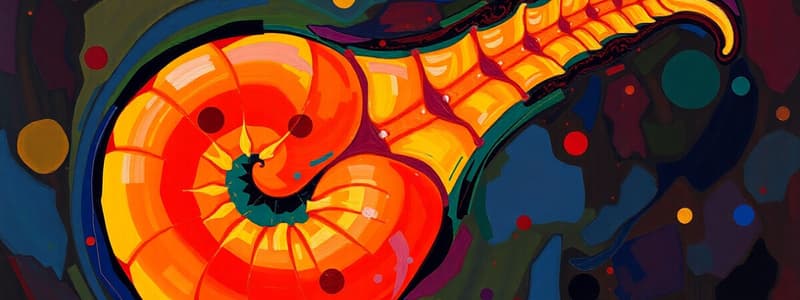Podcast
Questions and Answers
Which characteristic is consistently observed in chordates, even if modified or reduced during development?
Which characteristic is consistently observed in chordates, even if modified or reduced during development?
- Exclusive reliance on the tail for propulsion in all life stages.
- A tail located posterior to the anus at some stage. (correct)
- Absence of skeletal elements in the tail region.
- Presence of a fully developed tail throughout their entire lifespan.
What is the primary function of the tail in many aquatic chordate species?
What is the primary function of the tail in many aquatic chordate species?
- Providing the main propulsive force for movement through the water. (correct)
- Regulating buoyancy and maintaining a stable position in the water column.
- Attracting mates through elaborate displays and coloration.
- Filtering food particles from the surrounding water.
A biologist is studying a newly discovered marine organism. Upon examination, they observe a tail with skeletal elements and muscles extending beyond the anus. Which phylum does this organism likely belong to?
A biologist is studying a newly discovered marine organism. Upon examination, they observe a tail with skeletal elements and muscles extending beyond the anus. Which phylum does this organism likely belong to?
- Chordata (correct)
- Arthropoda
- Mollusca
- Echinodermata
In chordates where the tail is reduced during embryonic development, what happens to the skeletal elements and muscles that were initially present?
In chordates where the tail is reduced during embryonic development, what happens to the skeletal elements and muscles that were initially present?
Which of the following is NOT a typical characteristic or function of the post-anal tail in chordates?
Which of the following is NOT a typical characteristic or function of the post-anal tail in chordates?
Flashcards
Post-anal tail
Post-anal tail
A structure posterior to the anus found in chordates, often reduced during embryonic development, containing skeletal elements and muscles.
Tail's function in water
Tail's function in water
In aquatic chordates, this structure provides propulsion in the water.
Tail components
Tail components
The tail has skeletal elements and muscles which facilitate movement.
Study Notes
- Chordates possess a tail that extends behind the anus.
- In numerous species, the tail diminishes significantly as the embryo develops.
- The tail comprises skeletal components and muscles.
- It serves as a primary source of propulsion for various aquatic organisms.
Studying That Suits You
Use AI to generate personalized quizzes and flashcards to suit your learning preferences.




